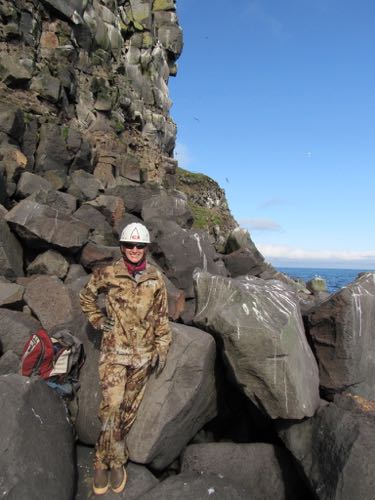If you're curious about how and where we work, here you go.
We've been leaving our place at 8am to head to our sites, and as a team of four, we split up. Punguk is our local Yupik guide, so he leads us to the further sites and helps with research duties, too.
 Let's talk four-wheeling, shall we?
Let's talk four-wheeling, shall we?
 The commute.
The commute.
We travel by ATV / four-wheeler, and alternate driving when we ride with a partner. It's incredibly rocky terrain thanks to the island's volcanic activity, and oceanic influences from below, and it takes a bit more than an hour to get to one cliff site.
 Auklets love to nest among these rocks.
Auklets love to nest among these rocks.
Once we arrive, we park the vehicles, climb down the cliffside to the rocks below, then do some bouldering to the nest sites. It takes some effort to get to work!
 Stunning office view.
Stunning office view.
 There's still snow on the cliffs!
There's still snow on the cliffs!
 No elevator to the office here.
No elevator to the office here.
 Some perspective on the office stairs. Can you spot Punguk?
Some perspective on the office stairs. Can you spot Punguk?
These cliffs are home to several seabirds, predominantly black-legged kittiwakes, but sit for a moment, and you'll hear, see, and be mesmerized by tufted puffins, horned-bill puffins, common and thick-billed murres, cormorants, pigeon guillemots, least auklets, crested auklets, and parakeet auklets. The Arctic ecosystem is teeming with life, and these cliffs are no exception.
 These black-legged kittiwakes rule the roost at these cliffs.
These black-legged kittiwakes rule the roost at these cliffs.
 These pigeon guillemots are a thrill to watch play and swim underwater.
These pigeon guillemots are a thrill to watch play and swim underwater.
Nests are monitored, and the team checks the nests to see if those that were banded in the previous two years are still present, whether there is an egg, or if the nest is empty.
 JB and Punguk heading to the first nest of the morning.
JB and Punguk heading to the first nest of the morning.
 Me, rocking the day wear. The helmet is for safety around all those rocks, and potentially falling rocks. Hate for that noggin to get bruised.
Me, rocking the day wear. The helmet is for safety around all those rocks, and potentially falling rocks. Hate for that noggin to get bruised.
 Office seating at its finest. JB taking notes on the spot.
Office seating at its finest. JB taking notes on the spot.
If the birds are present in the nests, they are captured, and various measurements are taken, but more on how that's done in a later post. Some nests need to be accessed from below, while others need to be accessed from above, entailing a bit of rappelling.
 Some nests have to be accessed from above, so rappelling is part of the fun.
Some nests have to be accessed from above, so rappelling is part of the fun.
We are typically out in the field until 7-8 pm, so 11-12 hour days are the norm. I am humbled by the diligence and drive of these researchers, and they still spend hours processing their work once we get back to base.
To make up for the immense hard work, though, four-wheeling, bouldering, rappelling, rock climbing, and dinner and a show (watching the birds while we break for lunch) all make this some of the coolest commute and office digs around.
Today's Tweet
Get outside. Observe wildlife with all your senses. Your body, soul, and mind will thank you for it. #NatureIsMedicine


Comments
Add new comment